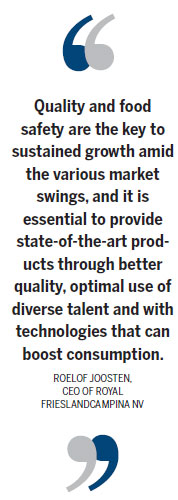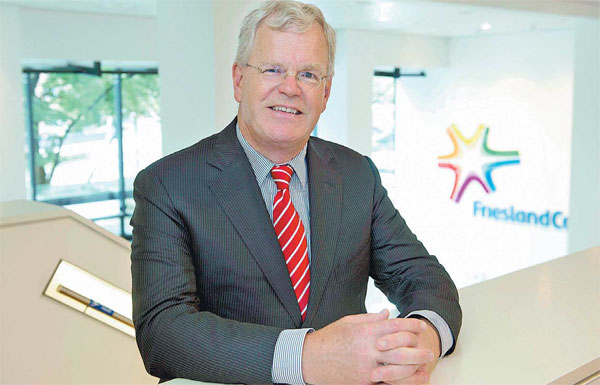Finding green pastures in China

Dutch-based dairy company banks on technology, talent for continued growth
As Roelof Joosten prepares to take the helm at Royal FrieslandCampina NV, he knows that his biggest challenge is to keep the growth pipeline robust in China, the Netherlands-based dairy company's biggest external market.
Joosten, however, is hopeful. That hope stems from the green light for the company's infant formula joint venture and the new brand it plans to introduce in China soon.
| Roelof Joosten, chief executive officer of Royal FrieslandCampina NV, says urbanization in China has pushed up demand for dairy products significantly, not only in terms of quantity but also in terms of quality and diversity. Provided to China Daily |
Joosten says FrieslandCampina's main focus would be to leverage its resources effectively in China's dairy market, and to effectively use his three-decade of expertise in the food sector and the more than two decades of management experience in various roles from technology to marketing.
"Quality and food safety are the key to sustained growth amid the various market swings, and it is essential to provide state-of-the-art products through better quality, optimal use of diverse talent and with technologies that can boost consumption," he says.
The 144-year-old dairy company has gone through several expansions and owes its present structure to a merger of Royal Friesland Foods and Campina in December 2008. The company, which has marketed its products in China since 1992, is now looking to strengthen its presence further by leveraging Netherlands' dairy industry strength. The China market accounts for about 10 percent of FrieslandCampina's global revenue.
China and the Netherlands signed a framework agreement on dairy industry cooperation last year, under which the European nation would help Chinese dairy producers to improve dairy product quality and quantity.
FrieslandCampina, which set up a subsidiary in Shanghai in 2008, has taken that to heart by forming a joint venture with Chinese dairy company China Huishan Dairy Holdings Co Ltd. The joint venture will manufacture, market and sell high-quality infant milk formula in China with an eye on having a fully integrated infant milk formula supply chain.
Both companies will continue to run their existing infant milk formula businesses separately. Huishan will provide high-quality raw milk from its own dairy farms in China and the joint venture will produce and market the infant milk formula.

"Huishan has strength in the upper stream of the supply chain and FrieslandCampina in the downstream, including technology, process management and marketing. We can also provide some midstream technologies," says Joosten.
Having a fully integrated supply chain means that the joint venture can take full control of the entire production process and also monitor food safety, says Joosten. "It helps addresses the most important concern of Chinese consumers."
Joosten says the market has seen a sea change in the past decade. While the per capita consumption of dairy products has risen tenfold, concerns about food safety have dragged down domestic brands. This has opened new growth pastures for multinational dairy corporations, all of whom have been trying to grow market share with aggressive approaches.
According to data from Rabobank, a Netherlands-based bank that focuses on food sector financing, the top five global dairy firms - Switzerland-based Nestle SA, France-based Groupe Danone and Lactalis, New Zealand-based Fonterra Cooperative Group Ltd and FrieslandCampina - have all been betting big on China with infant formula.
Some Chinese brands like Yili Group have also been investing heavily in research, safety and quality control and self-owned farm development to grow market share. Yili was among the top 10 dairy firms in the world last year, the Rabobank report says.
Joosten says having a hands-on approach is essential in China. A frequent visitor to the country, the 58-year-old Harvard graduate can converse fluently in Mandarin, while his knowledge about Chinese food (especially dairy products) is immense. At the same time, Joosten admits that finding the right talent has always been a major problem in China. "We need to hire more senior managers with local expertise," he says.
The immediate task for FrieslandCampina is to boost consumption of dairy products in China. While a Netherlands resident consumes more than 300 liters a every year, a Chinese resident consumes just 26 liters in that time, according to Rabobank.
Though the average dairy consumption of Chinese residents has risen from less than 3 liters per capita about a decade ago, it is still lower than most other Asian countries like Japan and South Korea, where the annual dairy product consumption per capita is about 78 liters.
Unstable raw milk prices and higher imports of overseas raw milk ingredients have prompted dairy farmers in some regions of China to pour milk into drains to reduce losses. Farmers are also apprehensive that prices might decline even further after the European Union lifted the quotas on milk production. The decision, effective in April, could cause global milk prices to fall further and increase global raw milk supplies by up to 4 percent.
However, Joosten says supply alone is not the culprit for falling prices. It is the supply and demand imbalance that is to be blamed and that needs to be fixed, he says. He cites the example of China to justify his point.
"China does not have excess milk supplies. In fact urbanization has pushed up demand for dairy products significantly, not only in terms of quantity but also in terms of quality and diversity. If the supply is not good enough to meet the demand, or the supply cannot be processed into the demanded products, then there is a so-called oversupply," says Joosten.
Farmers pouring milk down the drain happened in Europe some years ago. But the European farmers figured out measures to solve the "oversupply" issues, including improving quality of raw milk, building up a demand information platform, enhancing cold-chain logistics systems, and applying modern management processes. That enabled the sector to move from its original framework of household retailing within villages to the more modern organized landscape, Joosten says.
Demand in the Chinese dairy market is still robust, thanks to surging disposable income and growing supplies, enabling companies to cater to diverse requirements. Joosten says higher income, urbanization and the rise of the middle-class would also increase demands for a more nutritious diet.
Diversified dining habits will enable more people to purchase milk, butter, cheese, formula milk powders, and other dairy drinks and food. Innovation also will enable the dairy sector to provide more and better choices for consumers, says Joosten.
wuyiyao@chinadaily.com.cn
(China Daily European Weekly 06/12/2015 page22)
Today's Top News
- Japan tempting fate if it interferes in the situation of Taiwan Strait
- Stable trade ties benefit China, US
- Experts advocate increasing scope of BRI to include soft power sectors
- New engine powers cargo drone expansion
- China to boost green industry cooperation
- Manufacturing PMI rises in November































